YAMAHA YFZ50 2021 Workshop Manual
Manufacturer: YAMAHA, Model Year: 2021, Model line: YFZ50, Model: YAMAHA YFZ50 2021Pages: 126, PDF Size: 4.89 MB
Page 51 of 126
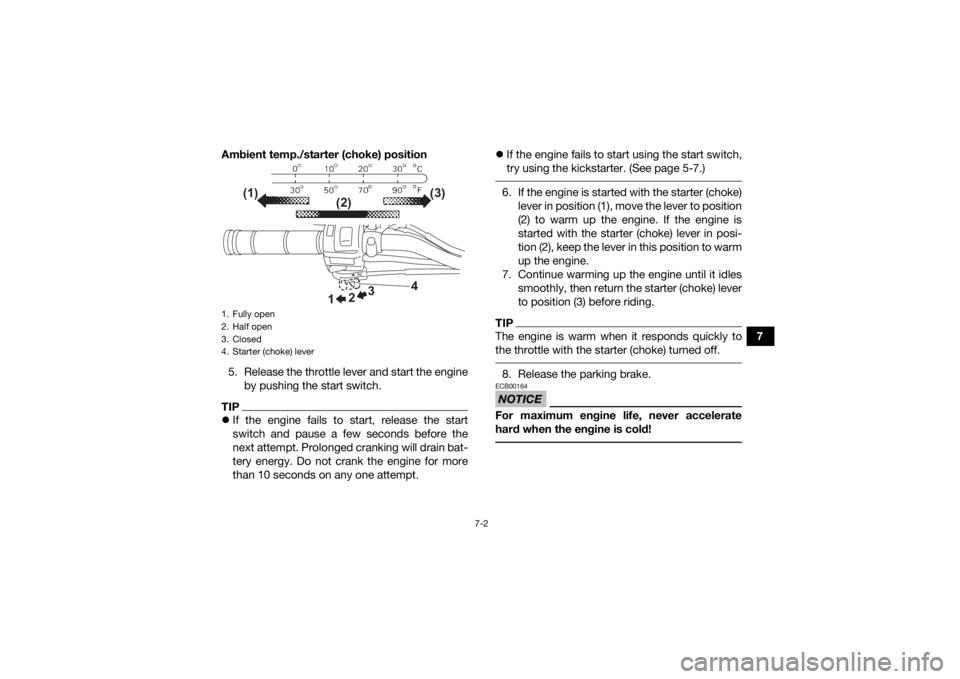
7-2
7
Ambient temp./starter (choke) position
5. Release the throttle lever and start the engine by pushing the start switch.
TIPIf the engine fails to start, release the start
switch and pause a few seconds before the
next attempt. Prolonged cranking will drain bat-
tery energy. Do not crank the engine for more
than 10 seconds on any one attempt.
If the engine fails to start using the start switch,
try using the kickstarter. (See page 5-7.)
6. If the engine is started with the starter (choke)
lever in position (1), move the lever to position
(2) to warm up the engine. If the engine is
started with the starter (choke) lever in posi-
tion (2), keep the lever in this position to warm
up the engine.
7. Continue warming up the engine until it idles smoothly, then return the starter (choke) lever
to position (3) before riding.TIPThe engine is warm when it responds quickly to
the throttle with the starter (choke) turned off. 8. Release the parking brake.NOTICEECB00164For maximum engine life, never accelerate
hard when the engine is cold!
1. Fully open
2. Half open
3. Closed
4. Starter (choke) lever
4
3
2
1
(1) (3)
(2)
UBW464E0.book Page 2 Thursday, January 23, 2020 2:42 PM
Page 52 of 126

7-3
7
EBU20292Starting a warm engineFollow the same procedure as for starting a cold
engine, with the exception that the starter (choke)
is not required when the engine is warm. Instead,
start the engine with the throttle slightly open.EBU36861Engine break-inThere is never a more important period in the life
of your engine than the first 240 km (150 mi) or 20
hours of operation. For this reason, you should fol-
low the engine break-in instructions carefully.
Since the engine is brand new, do not put an ex-
cessive load on it for the first 240 km (150 mi) or
20 hours. During this period the various parts in
the engine wear and polish themselves to the cor-
rect operating clearances. Avoid prolonged full-
throttle operation or any condition that might re-
sult in engine overheating.
0–120 km (0–75 mi) or 0–10 hours
Avoid prolonged operation above 1/2 throttle.
Vary the speed of the ATV regularly. Do not oper-
ate it at one set throttle position.120–240 km (75–150 mi) or 10–20 hours
Avoid prolonged operation above 3/4 throttle. Rev
the engine freely, but do not use full throttle at any
time.
240 km (150 mi) or 20 hours and beyond
The ATV can now be operated normally.
NOTICEECB00221If any engine trouble should occur during the
engine break-in period, immediately have a
Yamaha dealer check the ATV. EBU36370ParkingWhen parking the ATV, apply the rear brake lever,
stop the engine, apply the parking brake, and then
turn the fuel cock to “OFF”.
UBW464E0.book Page 3 Thursday, January 23, 2020 2:42 PM
Page 53 of 126
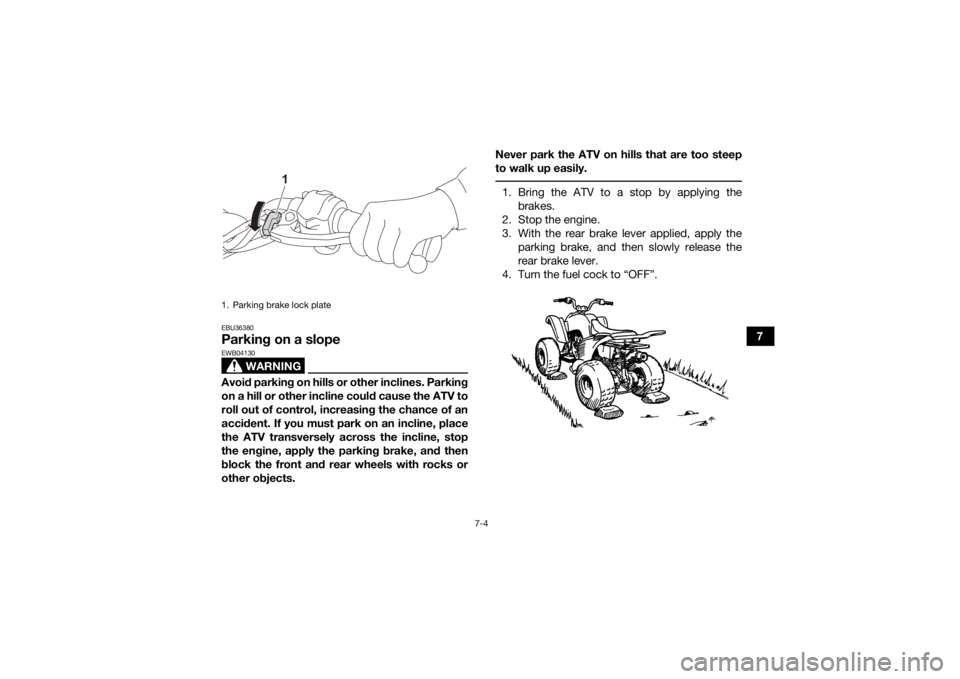
7-4
7
EBU36380Parking on a slope
WARNING
EWB04130Avoid parking on hills or other inclines. Parking
on a hill or other incline could cause the ATV to
roll out of control, increasing the chance of an
accident. If you must park on an incline, place
the ATV transversely across the incline, stop
the engine, apply the parking brake, and then
block the front and rear wheels with rocks or
other objects.Never park the ATV on hills that are too steep
to walk up easily.
1. Bring the ATV to a stop by applying the
brakes.
2. Stop the engine.
3. With the rear brake lever applied, apply the parking brake, and then slowly release the
rear brake lever.
4. Turn the fuel cock to “OFF”.
1. Parking brake lock plate
1
UBW464E0.book Page 4 Thursday, January 23, 2020 2:42 PM
Page 54 of 126

7-5
7
EBU20911Accessories and loadingEBU20922Genuine Yamaha Accessories
Choosing accessories for your ATV is an impor-
tant decision. Genuine Yamaha Accessories,
which are available only from a Yamaha dealer,
have been designed, tested, and approved by
Yamaha for use on your ATV. Many companies with no connection to Yamaha manufacture parts
and accessories or offer other modifications for
Yamaha vehicles. Yamaha is not in a position to test the products that these aftermarket compa-
nies produce. Therefore, Yamaha can neither en-
dorse nor recommend the use of accessories not
sold by Yamaha or modifications not specifically
recommended by Yamaha, even if sold and in-
stalled by a Yamaha dealer.
Aftermarket parts, accessories, and modifica-
tions
While you may find aftermarket products similar in
design and quality to genuine Yamaha Accesso-
ries, recognize that some aftermarket accessories
or modifications are not suitable because of po-
tential safety hazards to you or others. Installing aftermarket products or having other modifica-
tions performed to your ATV that change any of
the vehicle’s design or operation characteristics
can put you and others at greater risk of serious
injury or death. You are responsible for injuries re-
lated to changes in the vehicle.
Keep the following in mind when considering an
accessory or operating an ATV which has acces-
sories.
Accessories should be rigidly and securely
mounted. An accessory which can shift position
or come off while you are riding could affect
your ability to control the ATV.
Do not mount an accessory where it could inter-
fere with your ability to control the ATV. Exam-
ples include (but are not limited to) a heavy or
bulky object attached to the handlebars which
could make steering difficult, an accessory that
limits your ability to move around on the seat, or
one that limits your view.
Use extra caution when riding an ATV with ac-
cessories. The ATV may handle differently than
it does without accessories.UBW464E0.book Page 5 Thursday, January 23, 2020 2:42 PM
Page 55 of 126

7-6
7
EBU33880Loading
WARNING
EWB00821Never exceed the stated load capacity for this
ATV. Overloading this ATV or carrying or tow-
ing cargo improperly could cause changes in
ATV handling which could lead to an accident.
Cargo should be properly distributed and se-
curely attached. Reduce speed when carrying
cargo or pulling a trailer. Allow greater dis-
tance for braking. As originally equipped, this ATV is not designed to
carry cargo or tow a trailer. If you choose to add
accessories so that you can carry cargo or tow a
trailer, you must use common sense and good
judgment as the stability and handling of an ATV
can be changed. When adding accessories, keep
the following points in mind:
Never exceed the weight limits shown. An over-
loaded ATV can be unstable.
If you are carrying cargo and towing a trailer, in-
clude the tongue weight in the maximum ATV
load limit.
Load cargo on the carriers as close to the center
of the ATV as possible. Put cargo at the rear of
the front carrier, at the front of the rear carrier,
and center it.
Tie down cargo securely to the carriers. Make
sure cargo in the trailer cannot move around. A
shifting load can cause an accident.
Make sure the load does not interfere with con-
trols or your ability to see where you are going.
Ride more slowly than you would without a
load. The more weight you carry, the slower you
should go.
Allow more braking distance. A heavier ATV
takes longer to stop.
Avoid making sharp turns unless at very slow
speeds.
Avoid hills and rough terrain. Choose terrain
carefully. Added weight affects the stability and
handling of the ATV.
MAXIMUM LOADING LIMIT ATV loading limit (total weight of rider, car-
go, accessories, and tongue weight):41.0 kg (90 lb)UBW464E0.book Page 6 Thursday, January 23, 2020 2:42 PM
Page 56 of 126
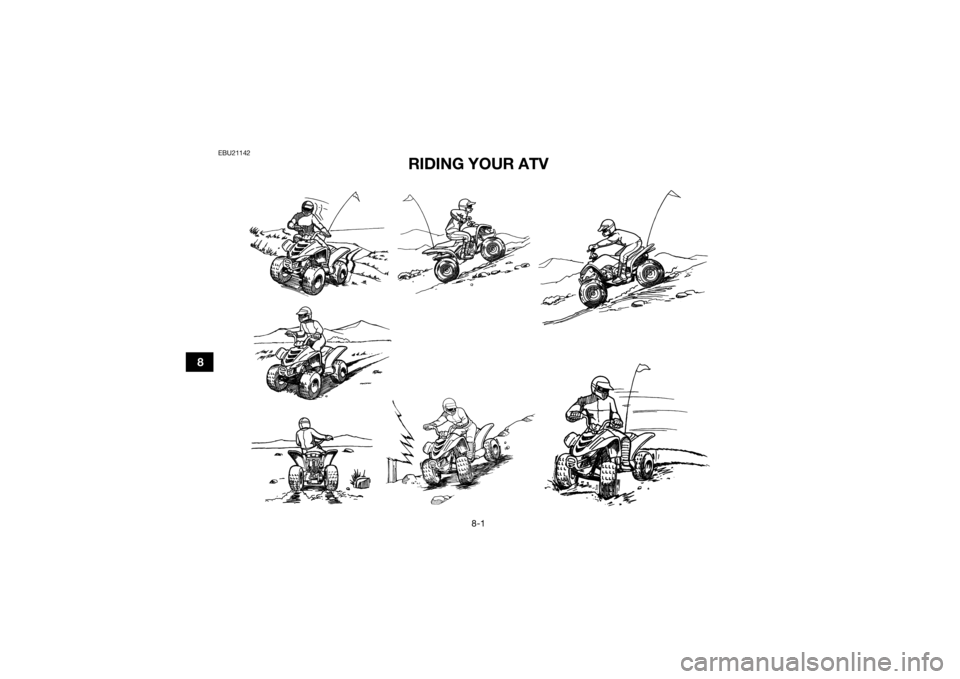
8-1
8
EBU21142
RIDING YOUR ATV
UBW464E0.book Page 1 Thursday, January 23, 2020 2:42 PM
Page 57 of 126

8-2
8
EBU21525GETTING TO KNOW YOUR ATV
This ATV is intended for recreational use by young
operators under adult supervision. This section,
“Riding your ATV”, provides general riding instruc-
tions which are appropriate for all types of riding.
Riding your ATV requires special skills acquired
through practice over a period of time. Take the
time to learn the basic techniques well before at-
tempting more difficult maneuvers.
Riding your new ATV can be a very enjoyable ac-
tivity, providing you with hours of pleasure. But it
is essential to familiarize yourself with the opera-
tion of the ATV to achieve the skill necessary to
enjoy riding safely. Before you begin to ride, be
sure you have read this manual completely and
understand how to operate all of the ATV’s con-
trols. Pay particular attention to the safety infor-
mation on pages 3-1 to 3-8 and all notice and
warning labels on the vehicle.RIDE WITH CARE AND GOOD JUDGMENT
Beginning riders should get training from a
certified instructor.
WARNING
EWB01382
Do not operate this ATV or allow anyone else
to operate it without proper instruction. The
risk of an accident is greatly increased if the
operator does not know how to operate the
ATV properly in different situations and on
different types of terrain.
Do not operate this ATV at speeds too fast
for your skills or the conditions, as this in-
creases your chances of losing control of the
ATV and an accident. Always go at a speed
that is proper for the terrain, visibility and op-
erating conditions, and your experience. Riding your ATV requires skills acquired
through practice over a period of time.
Become familiar with riding this ATV by riding at
slow speeds first, even if you have experience rid-
ing other ATVs. Do not attempt to operate it at
higher performance levels until you are familiar
with this ATV’s handling and performance charac-
UBW464E0.book Page 2 Thursday, January 23, 2020 2:42 PM
Page 58 of 126
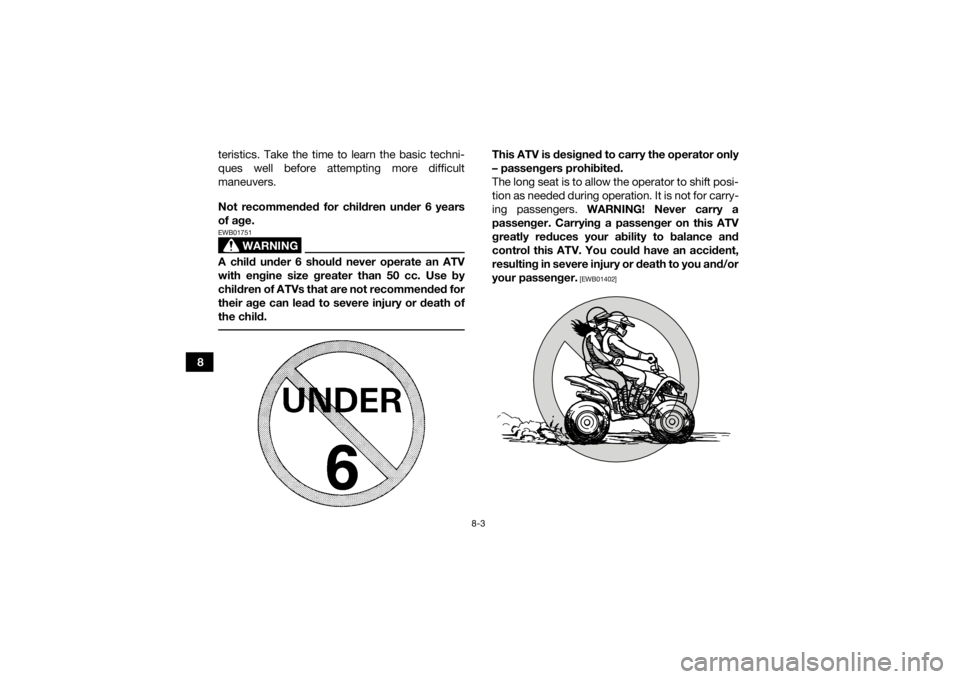
8-3
8teristics. Take the time to learn the basic techni-
ques well before attempting more difficult
maneuvers.
Not recommended for children under 6 years
of age.
WARNING
EWB01751A child under 6 should never operate an ATV
with engine size greater than 50 cc. Use by
children of ATVs that are not recommended for
their age can lead to severe injury or death of
the child.
This ATV is designed to carry the operator only
– passengers prohibited.
The long seat is to allow the operator to shift posi-
tion as needed during operation. It is not for carry-
ing passengers.
WARNING! Never carry a
passenger. Carrying a passenger on this ATV
greatly reduces your ability to balance and
control this ATV. You could have an accident,
resulting in severe injury or death to you and/or
your passenger.
[EWB01402]
UBW464E0.book Page 3 Thursday, January 23, 2020 2:42 PM
Page 59 of 126
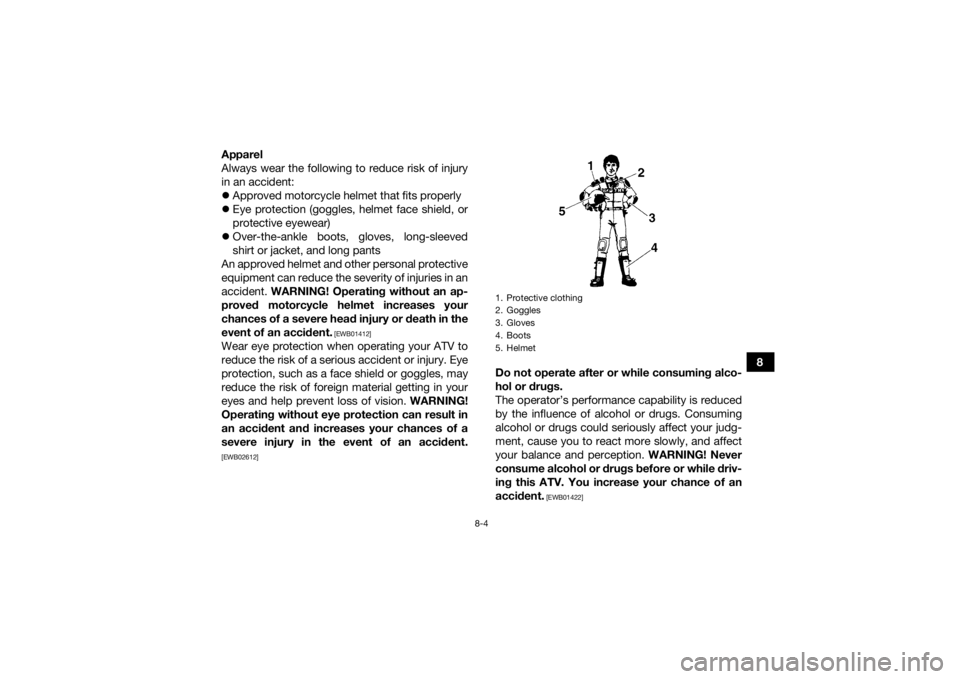
8-4
8
Apparel
Always wear the following to reduce risk of injury
in an accident:
Approved motorcycle helmet that fits properly
Eye protection (goggles, helmet face shield, or
protective eyewear)
Over-the-ankle boots, gloves, long-sleeved
shirt or jacket, and long pants
An approved helmet and other personal protective
equipment can reduce the severity of injuries in an
accident. WARNING! Operating without an ap-
proved motorcycle helmet increases your
chances of a severe head injury or death in the
event of an accident.
[EWB01412]
Wear eye protection when operating your ATV to
reduce the risk of a serious accident or injury. Eye
protection, such as a face shield or goggles, may
reduce the risk of foreign material getting in your
eyes and help prevent loss of vision. WARNING!
Operating without eye protection can result in
an accident and increases your chances of a
severe injury in the event of an accident.[EWB02612]
Do not operate after or while consuming alco-
hol or drugs.
The operator’s performance capability is reduced
by the influence of alcohol or drugs. Consuming
alcohol or drugs could seriously affect your judg-
ment, cause you to react more slowly, and affect
your balance and perception. WARNING! Never
consume alcohol or drugs before or while driv-
ing this ATV. You increase your chance of an
accident.
[EWB01422]
1. Protective clothing
2. Goggles
3. Gloves
4. Boots
5. Helmet
UBW464E0.book Page 4 Thursday, January 23, 2020 2:42 PM
Page 60 of 126
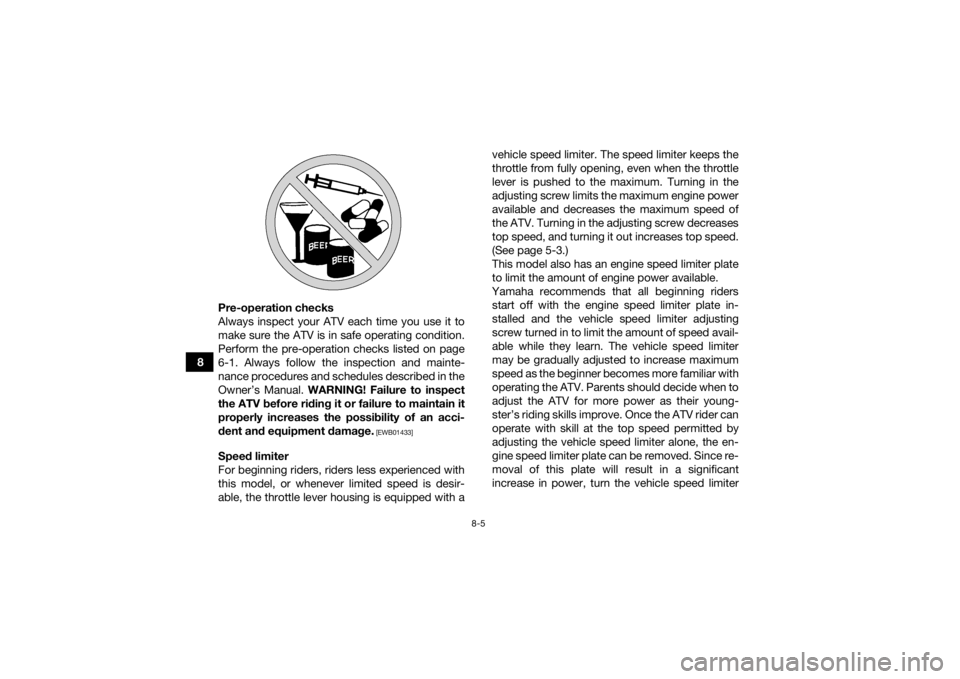
8-5
8Pre-operation checks
Always inspect your ATV each time you use it to
make sure the ATV is in safe operating condition.
Perform the pre-operation checks listed on page
6-1. Always follow the inspection and mainte-
nance procedures and schedules described in the
Owner’s Manual.
WARNING! Failure to inspect
the ATV before riding it or failure to maintain it
properly increases the possibility of an acci-
dent and equipment damage.
[EWB01433]
Speed limiter
For beginning riders, riders less experienced with
this model, or whenever limited speed is desir-
able, the throttle lever housing is equipped with a vehicle speed limiter. The speed limiter keeps the
throttle from fully opening, even when the throttle
lever is pushed to the maximum. Turning in the
adjusting screw limits the maximum engine power
available and decreases the maximum speed of
the ATV. Turning in the adjusting screw decreases
top speed, and turning it out increases top speed.
(See page 5-3.)
This model also has an engine speed limiter plate
to limit the amount of engine power available.
Yamaha recommends that all beginning riders start off with the engine speed limiter plate in-
stalled and the vehicle speed limiter adjusting
screw turned in to limit the amount of speed avail-
able while they learn. The vehicle speed limiter
may be gradually adjusted to increase maximum
speed as the beginner becomes more familiar with
operating the ATV. Parents should decide when to
adjust the ATV for more power as their young-
ster’s riding skills improve. Once the ATV rider can
operate with skill at the top speed permitted by
adjusting the vehicle speed limiter alone, the en-
gine speed limiter plate can be removed. Since re-
moval of this plate will result in a significant
increase in power, turn the vehicle speed limiterUBW464E0.book Page 5 Thursday, January 23, 2020 2:42 PM